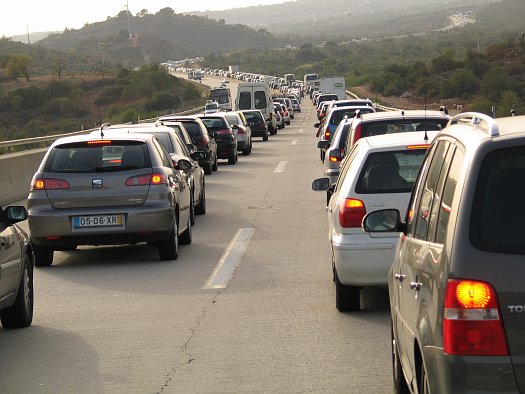What Causes Traffic Jams?
(4) Comments By Natalie Josef September 25th 2012

Where I live, in the San Francisco Bay Area, traffic jams are as common as the fog. A few weeks ago, I drove up to Sebastopol from San Francisco and before I knew it, my leisurely drive had turned into stop-and-go traffic. The traffic was so bad, I had to turn around to head back to the city before I had reached my destination so I wouldn’t be late for another appointment.
When I turned back and started heading the other way, suddenly I was in traffic again. I had seen the roadway on my way up and there had been no traffic—none at all—and now it was crawling along. And just when I was about to seriously freak out, we were moving again.
Long story short, I missed my first appointment and nearly missed my second, all because of phantom traffic jams that seemed to pop up and then dissipate like they had never happened.
What actually causes traffic jams? How do they seemingly materialize like paradoxical oases? Why do they suddenly clear up? What’s going on?
Why Traffic Jams Happen
How can things be moving along at one minute and then suddenly stop the next? This has always perplexed me. It’s the same reason I don’t understand floods. Why doesn’t the water just keep moving? Why don’t the cars just go?
Obviously, an accident can cause a traffic jam. And merges due to construction make sense, too. If you had four lanes and then suddenly only have two, of course traffic will build up.
But what about the traffic that seems to appear out of nowhere?
According to Craig Davis, a physicist at the University of Michigan, the cause of much traffic is selfishness of drivers. According to him, "It's the science of complexity. In large group dynamics, special things happen because each individual is trying to maximize their own benefit."
Davis, who has done research on how to decongest roadways, explains that tunnel vision and delayed reactions of drivers contribute greatly to bringing traffic to a screeching halt.
Let’s say you are driving along when suddenly, a bright red sports car darts in and out of your lane, wanting to pass another car that is moving too slowly for his taste. This makes you hit the brakes, which makes the driver behind you hit her brakes, and the driver behind her, and so on.
Now people are a little ticked and begin to move into other lanes, which had been moving along fine. But because of the new merges, these other lanes now slow down. This process repeats itself over and over until the entire highway has been affected. If the traffic was already dense, things may come to a complete stop. People may exit to avoid the problem and create traffic in town. It’s the proverbial snowball barreling down the hill.
And that guy in the red sports car? He’s probably already at home watching the news of the horrible traffic jam, never imagining his one action led to the gridlock.
Of course, this may all happen without the guy in the sports car. People who tailgate can begin the slam-the-brakes domino effect when they overreact to an event in front of them. It takes people about 3/4 of a second to hit the brakes—using a cell phone makes the response time even slower, which of course, can also make things worse.
The bottom line—it’s the butterfly effect. One little change can cause everything to change.